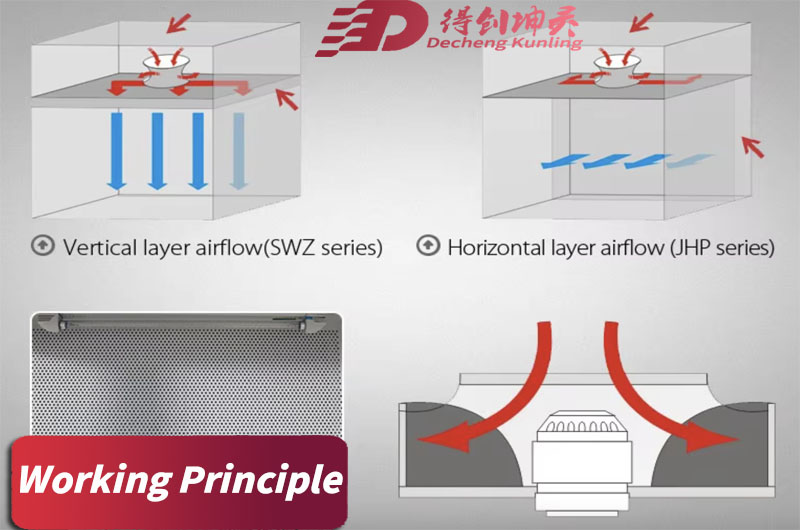LAMINAR FLOW Clean benchES
Essential Technology for Sterile Environments in Laboratories & Cleanrooms
Laminar flow clean benches play a crucial role in maintaining sterile environments in laboratories and Cleanrooms. These specialized workspaces provide controlled airflow to protect sensitive materials from contamination, making them essential in fields such as pharmaceuticals, biotechnology, and Electronics manufacturing. Understanding their purpose and functionality is vital for professionals who rely on cleanroom technology to ensure product integrity and safety.
Purpose of Laminar Flow Clean benches
The primary purpose of a laminar flow clean bench is to create a contamination-free environment for sensitive processes, ensuring that particulates and microorganisms are minimized.
- Protection of Samples: Laminar flow clean benches safeguard samples from airborne contaminants, ensuring the integrity of critical experiments and processes.
- Controlled Environment: These benches maintain a controlled airflow that protects against particulate matter, providing an ideal environment for handling sensitive materials.
- Versatile Applications: Widely used in pharmaceuticals, Electronics, and research laboratories due to their ability to provide a sterile workspace.
- Compliance with Standards: Adhering to international cleanliness standards helps organizations meet regulatory requirements.
- User Safety: By minimizing contamination, they also protect users from potential exposure to hazardous materials.
Working Principle
Laminar flow clean benches operate on the principle of unidirectional airflow, where filtered air moves in parallel layers.
- Unidirectional airflow minimizes turbulence and reduces contamination risk
- hepa filters capture particles as small as 0.3 microns
- Air passes through pre-filters and hepa filters before directed across work surface
Constant airflow creates a protective barrier against external contaminants

Is a Laminar Flow Hood Necessary?
Laminar flow hoods are essential for maintaining sterile conditions in sensitive applications. In laboratories dealing with cell cultures, pharmaceutical preparations, or electronics, the risk of contamination can lead to compromised results or defective products.
Laminar flow hoods provide a controlled environment that significantly reduces this risk, ensuring that the work performed is reliable and safe. As regulatory standards become increasingly stringent, the use of these hoods has become a necessity for compliance and quality assurance in many industries.
While not always mandatory, laminar flow hoods are highly recommended in environments where contamination poses significant risks.
Components of Laminar air flow Bench
Main Components
- Work Surface: Area for performing sterile procedures
- hepa Filters: Remove particles down to 0.3 microns
- Blower Systems: Generate consistent airflow
- Control Panels: Allow adjustment of airflow parameters
Airflow System
The airflow system pulls ambient air through pre-filters and hepa filters. The filtered air is directed horizontally or vertically across the work surface. Regular filter maintenance is crucial for optimal performance.
Safety Features
Many benches include UV lights to disinfect surfaces before and after use, further enhancing the sterile environment.
Advantages & Disadvantages
Advantage
They provide a high level of contamination control.
Disadvantage
Limited protection against hazardous vapors or fumes.
Conclusion
While laminar flow benches excel in reducing particulate contamination and are vital in sterile environments, they do not provide personal protection against chemical exposure. This limitation necessitates the use of additional safety equipment, such as fume hoods, when working with volatile substances. Compliance with standards such as ISO 14644 ensures that laminar flow benches meet the necessary cleanliness requirements for various applications.
Cleaning Procedure
Regular cleaning of a laminar flow hood is essential to maintain its sterile environment.
- 1Initial Inspection: Before cleaning, perform a thorough inspection to identify visible contamination or damage. Ensure the hood is turned off and all materials are removed.2
Cleaning Procedure: Wipe interior surfaces with a suitable disinfectant or cleanroom-approved solution. Use lint-free wipes, paying attention to corners and edges. Allow disinfectant to dwell for recommended time.
Filter Maintenance: Regularly check and replace hepa filters per manufacturer guidelines. Clean or replace pre-filters as needed. After cleaning, restart the hood and run for 15-30 minutes before resuming work.
By adhering to these cleaning protocols, users can ensure that their laminar flow hood operates efficiently and maintains the necessary sterile conditions for sensitive applications.
Laminar Flow Clean Benches: Essential Technology for Sterile Environments | Laboratory Equipment Solutions
© 2025 cleanroom technology Journal. All rights reserved.
 +86 18186671616
+86 18186671616 Jason@cleanroomequips.com
Jason@cleanroomequips.com
 MENU
MENU



